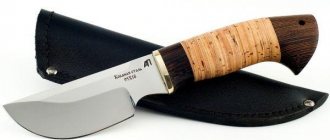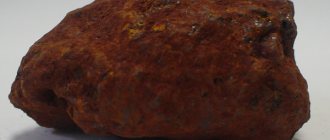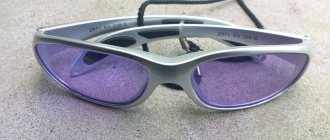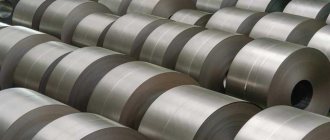If the chemical composition of damask steel or damascus is practically the same, then the technology for forming these steel options differs, which provides a noticeable difference in the structure and their properties. Both materials have the famous pattern that is the hallmark of these steels, and therefore even a non-specialist can recognize them.
Damascus steel.
What is real damascus and damask steel
The difference between damask steel and Damascus steel is due to the peculiarities of the production process.
Previously, the technology for making such weapons was kept secret - only craftsmen knew how to make Damascus steel, and the products themselves were highly valued and incredibly expensive. However, even now knives made from these materials are an expensive pleasure, so a considerable percentage of models belong to the category of collectible weapons.
Damascus
The technology for producing Damascus steel involves forging twisted carbon steel rods/plates. Due to forging, the layers are flattened and become very thin - the multilayer structure provides the blade with the necessary strength characteristics.
Bulat
Unlike Damascus, damask blades are made by casting. According to the technology for preparing damask steel, high- and low-carbon steels are used - as a result of melting, the melt with a low carbon content contains partially molten particles of the high-carbon component.
This two-component texture ensures the formation of the famous pattern - it is arbitrary and does not repeat itself due to the chaotic arrangement of the components during the melting process.
The difference between damask steel and damask
The advantages of damask steel and Damascus steel have divided lovers of such weapons into two camps. So when choosing, buyers rely more on personal preferences. As mentioned above, even by external signs (by drawing), clearly identifying these materials is not a problem.
Damask steel.
Manufacturing technology
The loss of the original technique did not stop people from trying to create this legendary material. Some have dedicated their entire lives to trying to recreate it. This type of work is even considered part of the larger field known as experimental archaeology. It is dedicated to approximating the technological feasibility of ancient cultural practices in order to gain a better understanding and deeper knowledge of said cultures.
Kharalug
Refined steel is mistakenly referred to as Damascus, but this is incorrect. The purpose of welding in a forge in this case is to clean the material from impurities and obtain metal with an acceptable level of carbon. During the processing process, carbon compounds are evenly distributed over the workpiece, and the resulting pattern is a side effect.
Welding of workpieces
The method was first developed by William F. Moran (now a famous knife designer and founder of the American Society of Blacksmiths) and presented at the Knifemaker's Guild exhibition in 1973. The method is also known as pattern welding. This technique requires the blacksmith to:
- I took several different alloys of steel and iron.
- I welded them together into a blank (steel rod or cylinder).
- Processed and folded it until the desired patterned appearance was formed.
This option came to be commonly (and erroneously) called "Damascus". Although this technique can create incredibly gorgeous and strong alloys, the actual method is far removed from that used in ancient Syria.
Bulat
The legendary Damascus is the result of mixing welded Damascus composites with damask steel - a material welded in a crucible, with a higher proportion of carbon in the composition compared to Damascus steel. In some countries, Damascus and damask swords are equated, but in the East and in Russia it is customary to clearly separate them. However, it has been proven that Damascus steel is false damask steel; it is not correct to confuse or identify them. There is also a misconception that damask steel is wootz. In fact, any crucible steel can be classified as Wootz.
Now damask blades are distinguished by improved mechanical characteristics in comparison with Damascus blades or products made from simple carbon steel with the same level of carbon in the composition. The reason for this lies in technology. The steel is first hardened, then the body of the knife is subjected to a high tempering, and its blade is subjected to a low tempering.
Damascus steel is divided into 2 classes:
- Crucibles are boiled in a crucible, cooled together with it, and then forged into strips.
- Cast steel is made by annealing cast steel for a long time under certain conditions. It has improved properties compared to the crucible type.
Characteristics of Damascus steel
The main characteristic of this material that users are interested in is hardness. Depending on the maintenance chosen by the manufacturer and the product itself, it can range from 61 to 64 Rockwell units.
In practice, this means that the blade holds an edge well, which is why such models are still valued.
Does Damascus rust?
Since Damascus is a forged package of carbon steels, there is no need to talk about good corrosion resistance - there are practically no alloying elements in the composition.
Chemical composition
Due to the manufacturing characteristics, it is not homogeneous. The composition includes both stainless steel grades with a high chromium content and low-alloy ones.
The norms and quantitative content of alloying components of Damascus steel are not regulated by any domestic or foreign standard. It is produced differently in each workshop, so the content of chromium and other metals in each blade is different. As a rule, the quantitative carbon content in it does not exceed 2%.
The amount of other alloying components depends on the set of components from which it was made.
For example, for manufacturing, blacksmiths can use the set of steels presented in the table.
| Name | Alloying component | Mass fraction in metal, % | Purpose |
| X12MF | WITH | 1,45 – 1,65 | Carbon gives the alloy hardness and increases wear resistance. |
| Cr | 11,0 – 12,5 | Increases the metal's resistance to corrosion and improves its wear resistance. | |
| V | 0,4 – 0,6 | The use of vanadium improves hardness and extends its service life. | |
| Ni | 0,15 – 0,3 | Alloying the metal with nickel increased its strength and corrosion resistance. | |
| 40Х13 | C | 0,36 – 0,45 | Gives the metal hardness and makes it more resistant to wear. |
| Cr | 11,0 – 12,5 | Chromium prevents local corrosion of the alloy. |
Types of Damascus
There are at least eight types of Damascus steel. Before listing the types of Damascus, it is worth making a short note.
In general, it is possible to make stainless Damascus. To make this possible, it is necessary to assemble a package of steel alloyed with the “correct” additives and weld it in a vacuum. Next, apply in layers and unchain.
Then repeat this cycle. This is a technically complex process, but modern technologies can cope with the task. For example, today they make kitchen knives with patterned stainless steel linings.
Types of Damascus:
- “wild” - got its name because of the disordered pattern. The technical process for making such steel is the most primitive - a welded package of steel is forged, cut into pieces, folded and forged again - the process is repeated many times.
- simple - characterized by a consistently repeating pattern. The technical process is virtually no different from wild material.
- stamped - the name was a consequence of the use of the so-called stamp with a pattern, which appears on the blade. Such patterns can resemble wood rings, stairs, circles on water, etc.
- mosaic - in this case, a special package of steels is selected to prepare a layered structure - they are assembled like a mosaic, which allows you to get a beautiful decorative effect. A subspecies of this type is mosaic end damascus: it is a blade with welded strips of mosaic damascus cut from the end of the finished block - such a strip can also be used as the middle of the blade.
- mosaic powder - this type of damask is not typical for the Russian Federation, but in technology it is actually no different from ordinary mosaic. Instead of strips of steel, the pattern is made from steel powder, which is poured into a metal can, sintered, and then forged.
- twisted - for the so-called twist, the workpiece for forging is made from twisted rods. By adjusting the twist angle and cutting depth, you can get different patterns.
- fibrous - this type is used in the production of high-quality Japanese swords. When forging Damascus, the hairs of steel are not stretched over the entire length of the blade, but, on the contrary, are finely chopped and arranged in layers at right angles. In structure and appearance, this material is very similar to damask steel.
- A multi-row Damascus blade is made from several strips of Damascus - a simple Damascus is usually installed in the center, and layers with a beautiful artistic design are placed on the surface.
Knives and other edged weapons made of Damascus steel
This material is used for the production of sabers and other collectible edged weapons or models for household use - these can be household and tourist knives, as well as kitchen, fishing and other knives.
Damascus steel knife.
Household and travel knives
Household and travel models are optimal for cutting meat, fish, poultry, vegetables and fruits. The high hardness of the blade does not require constant sharpening of the model, so they are convenient both in the kitchen and on the go.
How to sharpen a Damascus steel knife
To sharpen a Damascus knife with your own hands, you need to consider the following nuances:
- part of the blade with nicks and chips needs to be cut down for alignment;
- sharpening the knife is done slowly and carefully so that one layer of the layered structure does not bend onto another - for this, abrasive materials with successively decreasing grain size are used;
- sharpening is carried out diagonally - sharpening the blade lengthwise is ineffective;
- sharpening grooves and stripes spoil the design of the product - they need to be polished with a fine-grained material;
- The sharpened knife must be wiped with a napkin; you can use lemon zest.
Sharpening a knife made of pre-Mas steel.
Features of operation
The service life of a Damascus knife is affected by its correct sharpening. Before starting the procedure, study the hardness of the material. Next, pay attention to the factory sharpening angle; this should be preserved . Stick to a 45 degree angle.
The knife should be sharpened very carefully so as not to bend the soft layer onto the hard one on the edge of the blade. Otherwise, despite its external sharpness, the blade will turn out to be dull when used.
Before sharpening, do not forget to inspect the blade for damage or chips. If you sharpen such a surface, the sharpness will be seriously affected.
You cannot use automation in this process, only the manual method. You should feel the layers being peeled away.
Stages:
- Use a coarse abrasive to remove the old layer. This step accounts for 80% of all work. Minimum 5 minutes required. To achieve the best result, forget about sudden and jerking movements. Use the abrasive evenly and smoothly along the blade. Do not press too hard, otherwise you will damage the soft layers. Cross sharpening is not acceptable.
- Start decorative sharpening. To do this, use a fine-grain abrasive. Grind carefully, remove scratches, improve the appearance of the blade.
- The final step is to wipe with a napkin soaked in lemon juice. If there is no juice, you can replace it with zest and seal with beeswax.
Due to its low corrosion resistance, the blade must be stored in oil. If you ignore this rule, as a result of rust damage, the knife will quickly lose its external and operational properties.
Prospects for Damascus knives
The striking advantages and no less significant disadvantages of Damascus steel knives limit their popularity.
Low corrosion resistance and the need for careful handling and maintenance after each use make the Damascus blade not the most convenient; modern alloys are more technologically advanced and convenient. But collectible Damascus blades still remain one of the most beautiful gifts.
Previous
KnivesSteel K390 - popular carbon from Bohler
Next
Knives Vanadis 10 - Swedish powder steel from Böhler







